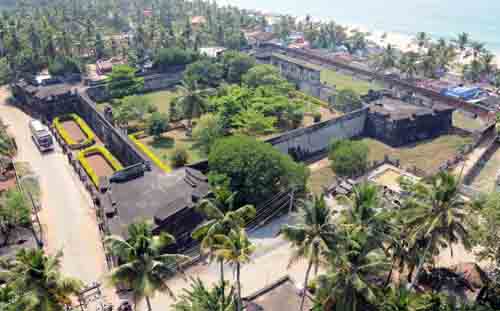Anchuthengu Fort

Information on Anchuthengu Fort (Thiruvananthapuram, Kerala) - History & Architecture
The Anchuthengu Fort is situated in the Thiruvananthapuram District in the state of Kerala. The fort is one of the most attractive monuments build during the time of the British India. In its initial days after the constructed the fort was used by the English as a signalling station for their ships.
Anchuthengu Fort Architecture
It was evident that the architecture of the fort has the influence of the western style. The fort was quite different in terms of shape, size and design as compared to other monuments in Kerala. The fort was surrounded with high walls since it was used extensively during war to store the armoury of military. The fort has numerous lookout points from where the great view of the island can be witnessed. There were two gateways within the fort which were in the eastern and the western end. The small villages and beaches within the fort are also among the major architectural features of the place. However, the fort is quite small in size for which there is no restroom kept for the visitors. There is a garden established by the British which enhances the ambience of the place. One important architectural feature of the fort is that all the historical information within the fort are written in English further making it easy for the visitors to read. There is also 130-feet high light house within the fort that was to provide signals to the ships by the British. There are also tombstones within the fort that were established by the year 1704.
Anchuthengu Fort History
The fort is located in a small island situated in the Anchuthengu Island in Varkala. The place has a long history at its back owing to the residence of the Portuguese and the Dutch rulers in the past. The fort is located amid the sea and backwaters within the island. The fort was primarily built in between the period of 1690 to 1695 by the East India Company to endorse trade. With the use of the fort the company used to conduct trade with various other countries with waterway as the prime mainly in the northern side of the fort. The fort was also served as a depot to store armoury and other equipments for military of the British east India Company. In the year, 1721 a revolt started against the activities of the British where queen of the place signed a treaty with the British in the fort where the Company was made obey the trade rules set by the local people. The fort also served as a store house of weapons during the Anglo Mysore war. It was with the permission of the Queen, that the East India Company expanded the fort.
Anchuthengu Fort Tourism Importance
The historical and architectural importance of the fort along with its natural beauty makes it an appropriate tourist destination all over Kerala. Near to the fort Thaipusam festival is observed by the local people during the month of January each year. The festival provides opportunity for people to experience the disciples to pierce their mouths and back with sticks made of metal. This is one of the ritual attractions of the festival that take place in and around the fort. Travelling to the fort through the roadways has also become convenient for the tourists with the establishment of the new roads. All this factors will attract the tourism sector.
- Andaman Nicobar Monuments
- Andhra Pradesh Monuments
- Assam Monuments
- Bihar Monuments
- Chhattisgarh Monuments
- New Delhi Monuments
- Goa Monuments
- Gujarat Monuments
- Haryana Monuments
- Himachal Pradesh Monuments
- Jammu and Kashmir Monuments
- Karnataka Monuments
- Kerala Monuments
- Madhya Pradesh Monuments
- Maharashtra Monuments
- Odisha Monuments
- Punjab Monuments
- Rajasthan Monuments
- Tamil Nadu Monuments
- Telangana Monuments
- Uttar Pradesh Monuments
- West Bengal Monuments